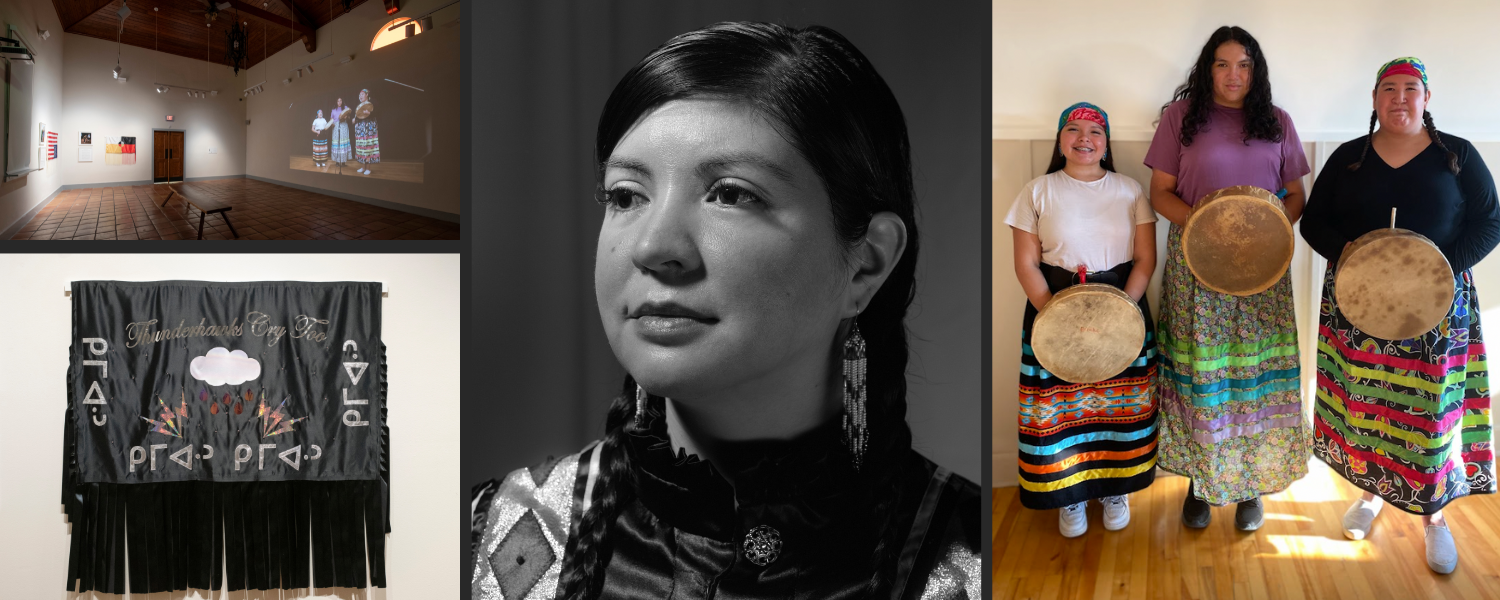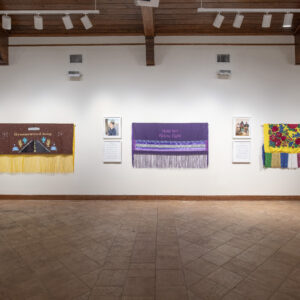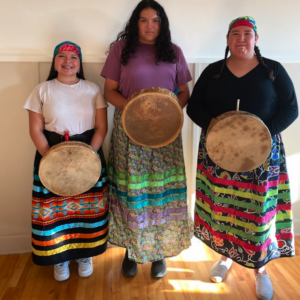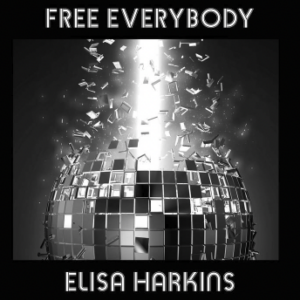Oklahoma Artist Elisa Harkins Shares Her Indigenous Song Exchange Project
By Becky Brown

Mix tapes weren’t anything new. Sharing music goes back thousands of years.
This simple concept inspired Oklahoma artist Elisa Harkins. Her ongoing project, Teach Me a Song, asks Indigenous artists to perform a tune on camera.

Teach Me a Song at Crisp-Ellert Art Museum (CEAM). Photography courtesy of Elisa Harkins. Elisa’s process includes recording the song, transcribing it to sheet music, a portrait photo, and creating a representative shawl.
“It’s a song exchange project,” Elisa says. “My first language teacher said that an old Indigenous practice was to go to a different community and do song trading. That’s what’s happening. It’s a cultural exchange.”
Of Cherokee and Muscogee heritage, Elisa didn’t set out to focus on language preservation. But that’s where her socially engaged art practice has taken her. And the Mid-America Arts Alliance’s Interchange artist program has helped make the journey possible.
Social change projects show the specific is universal.
A creator of electronic music with a background in interactive media, Elisa studied at CalArts. There, a studio visit with artist Wendy Red Star changed her approach to her art.
“She said, ‘I think you should hone in on something that would make your work specific,’” Elisa says. “I thought about it. Our language—the Cherokee language—is something that really sets us apart. And the work of language revitalization is so important.”
So Elisa set out to create pop music in Cherokee. Although she has relatives who speak the language, Elisa was not fluent. So, she decided to teach herself with online resources. Now, she’s also a student of the Mvskoke language. And in hindsight, it all seems fated.
“I told Joy Harjo how I had an imaginary friend growing up, and this friend would come to me and we’d speak our own language,” Elisa says. “Joy told me, ‘That was your ancestor who was teaching you Mvskoke.’”
Indigenous languages expand both the creation and reach of community-based art.

The White Buffalo Singers. Photography courtesy of Elisa Harkins.
With Teach Me a Song, Elisa records a song on camera, then teaches a song off camera. But that’s just the start.
“In addition to recording the song, I’ll also transcribe the song into sheet music, and pick a photo and make a shawl that’s a portrait of that person or represents the song somehow,” she says.
Interchange awarded Elisa a grant to support Teach Me a Song. This funding enabled her to travel with the project, including to Lethbridge, Alberta, Canada. There, she recorded several Indigenous performers, including the White Buffalo Singers, a group of Blackfoot teens.
“Visiting Alberta was really a culture shock. It’s so conservative, with a palpable sense of ‘This is our land, get these natives out of here,’” Elisa says. “The White Buffalo Singers includes a teen who is trans. To see them be trans in that place was beautiful, and to see all the teens singing ‘The Grandmother’s Song?’ It was inspiring to see these teens being leaders.”
At the beginning of Teach Me a Song, Elisa wasn’t sure how to approach performers. She wanted to be sensitive about sharing sacred music. But now that the project has grown, people want to contribute their music. The project acts as an archive, and the videos help performers market their work as well.
It’s social practice art that elevates and promotes Native artists’ music—and continues to grow.
Teach Me a Song is designed to be an ongoing socially engaged practice. Work from the project has appeared at galleries like Crisp-Ellert Art Museum in Florida, The New Gallery at Austin Peay State University in Tennessee, and Halsey Institute of Contemporary Art in South Carolina. But it’s only part of Elisa’s ongoing work highlighting Indigenous music. In addition to creating her own music, she hosts the nation’s only all-Indigenous radio show, Mnhayv Radio.
“It’s called ‘Teacher,’” Elisa says. “The show goes through all genres—Indigenous metal, moccasin gaze, noise music, round dance songs, peyote songs, hip hop.”
Her next project is a documentary about Angel Mounds in Indiana. Muscogee leaders believe this historic site was once home to their ancestors. Muscogee Nation may be entitled to reclaim a treasure trove of artifacts and the remains of hundreds of ancestors. Elisa is partnering with an archeologist and tribe leaders to investigate. A Creative Capital Award is enabling her to explore this complex issue.
Supporting artists is more than dollars and cents.
Art changes lives, and its impact is ongoing.
“I had a really great experience with Interchange. It was nice to meet other socially engaged artists,” Elisa says. “And it’s great to meet people who are supportive and really excited to see the work. The grant means I can share the project not only during the grant cycle but for years to come.”
Header photography (L-R): Teach Me a Song exhibition installation image from at Crisp-Ellert Art Museum (CEAM) in St. Augustine, Florida; Shawl for Cheyenne Rain Le Grande’s performance of “Thunderhawks Cry Too,” written by Cikwes; Elisa Harkins portrait; The White Buffalo Singers. Photography courtesy of Elisa Harkins.
Teach Me a Song by Elisa Harkins will be on view at M-AAA’s Culture Lab, 2018 Baltimore Avenue in Kansas City, Missouri, January 3 through April 5, 2025.


